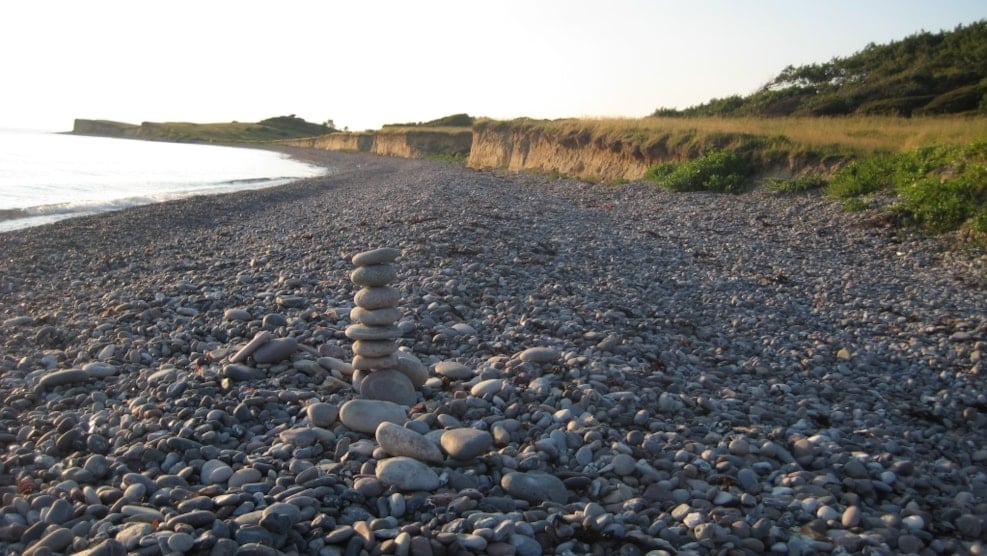
Sydlangeland
For many years, Sydlangeland (Southern Langeland) including Gulstav Mose, Gulstavskovene, Ørnehøj, Dovns Klint and Keldsnor has been known as a great bird migration place, especially in the fall.
Introduction
Over the last couple of years, the area totalling 5,4 km2 has developed into a favourite destination for anglers, bird watchers, and people who are interested in nature in general.
Habitat description
The landscape varies quite a bit. Keldsnor, which is located east of Gulstav, is a large cove separated from the sea by a stony beach ridge. Inside the beach ridge you find salt meadows stretching like tongues into the cove. Gulstav Mose (Gulstav Marsh), which is a bird sanctuary, is located between Gulstav Øster- and Gulstav Vesterskov (Gulstav East and West Forest). Here is a particularly rich bird and plant life. Along the coast, you find partially eroded moraine or “hat-shaped” hills (dislocated kames) creating upwards of 15 m tall cliffs down to the shingle beach. The beach is noted for its distinctive beach ridges consisting of well-rounded pebbles.
The southern forests in the area, Østre and Vestre Gulstav, as well as the small forest Eget, are particularly interesting in that they were originally coppiced woods. Coppicing is a very old and original type of forestry that has been employed since the Viking Ages whereby you cut down the trees and then let them grow up again from new shoot from the stumps. The Danish Nature Agency, which owns the forests, has decided to continue this culture-historical type of forestry. This type of forestry entails that large or small areas of the forest are cut down in rotational periods of 10–20 years. Immediately after the coppicing, the forest floor is exposed to additional light, which results in a flourishing of many types of herbs.
In a large enclosure stretching from Søgård to Gulstav, the Danish Nature Agency has released wild horses of the breed Exmoor pony that are allowed to roam freely with as little interference as possible. Exmoor ponies resemble the European wild horse that once existed in Denmark. The horses are outdoors all year and are only fed if there is no food available to the horses. The wild horses are a great attraction to the guests in the area.
The area also has several distinct hat-shaped hills. Several of these are in areas tended by the wild horses. From Fakkebjerg, which is the highest point in the area (37 m), you have a fantastic view over the whole area— on clear days you can see all the way to Germany!
The hat-shaped hill Fredsbjerg, located close to Bagenkop, has been designated as a Natura 2000 area in that the very diverse forest allows the visitors to learn about the various types of forest and the immigration of trees into Denmark.
Value
Over the last few decades, the area has developed significantly. Originally it was an area where the landscape was the main feature with a less interesting area usage, primarily as farmland. With the purchase by the Danish Nature Agency and the subsequent establishment of contiguous nature and grass areas, the area has developed into a locale of high value and national importance. Both with regard to the landscape itself and its biodiversity. This is supported by the fact that upwards of 100.000 guests visit the area every year.
Protection and legislation
The conservation of 1961 covers an area of 0.25 km2 of the Dovns Klint and surrounding meadows. East of Dovns Klint lies the large system of stone beach ridges that cuts off Keldsnor from the sea and forms the border between the public and the privately owned areas. The purpose of the conservation is primarily to preserve the landscape including keeping the area free of any buildings. The whole area is protected as a part of Natura 2000 No. 127, The South Funen Archipelago, Habitat area H111. Additionally, several other local areas are covered by Section 3 of the Nature Conservation Act.
Public access
The area has developed into a much visited nature attraction having hiking trails, parking options, good toilet facilities, bird towers, information centres with picnic tables and facilities for the anglers. Here is room for everyone.